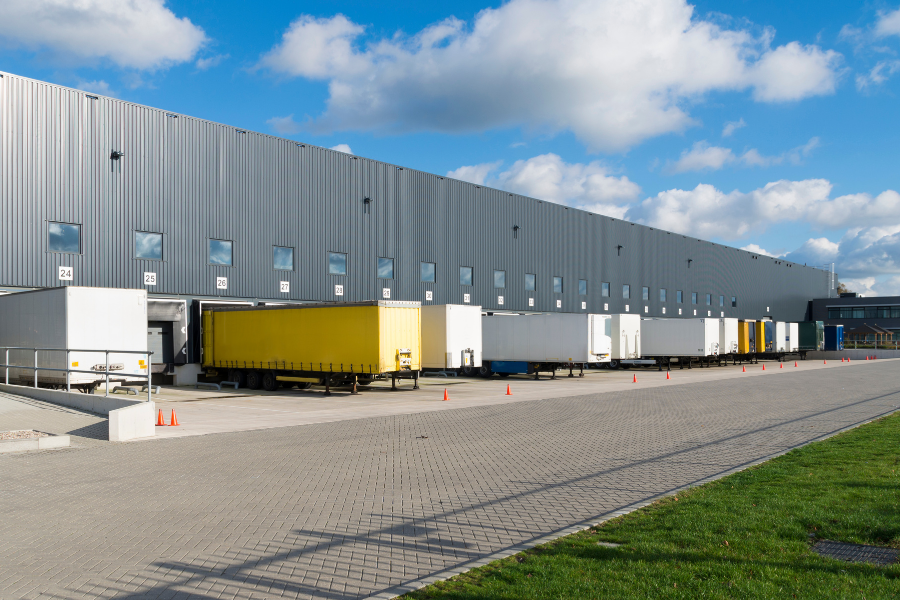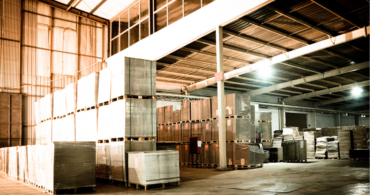Although it’s called a supply chain, a more accurate description is a web of interconnected hubs. While every stop on this web is essential, perhaps the most important locations as the supply chain nears its conclusion are warehouses, which have never been in such high demand. Naturally, anyone looking to enter this lucrative market wants to know, “How much does it cost to rent a warehouse?”
Here’s how shopping used to work. A person would go to a store. This entailed putting on pants, driving a car, fighting crowds, perusing the supply available at the location and dealing with people. However, that effort meant that you had the item immediately.
Today, in this global economy, ecommerce is king. When shopping online, you don’t have to put on pants, leave your home or deal with anyone. You also have the unlimited supply of the entire internet available at your fingertips. The tradeoff is that you must wait for your sparkly, new item to be shipped to your home.
People don’t like waiting. They also, increasingly, dislike leaving their home. However, those two factors had a funny effect on the supply chain. Instead of people adapting to the idea of waiting for an item to arrive at their home, the supply chain has adapted to their innate impatience by adding several small(ish) “fulfillment centers” in population-dense cities to the large (or massive) storage warehouses in outlying areas.
This increased demand for warehouses in and around cities dramatically affected the cost of warehouse space.
How much does a warehouse cost to rent?
From June 2021 to June 2022, the total cost of warehouse rent (including service charges and taxes) increased by 8.4%. Over that same timeframe the following year, from June 2022 to June 2023, total warehouse costs increased on average 10.1% globally. That’s according to Savills World Research’s annual analysis of 52 warehousing markets.
According to Paul Tostevin, director of Savills World Research, “Higher costs are here to stay. Even in the currently cheapest locations, in the long term, population growth and structural trends are likely to fuel demand for goods and services and, in turn, warehouse requirements; this applied not only to developing economies, but in the growth hotspots of developed ones. That only increases occupier emphasis on the best located, most efficient warehousing space, underpinning demand for prime warehouses and, in turn, future rental growth.”
The report found that warehouse rental cost is most expensive in the following seven cities:
- London, England.
- Sydney, Australia.
- Los Angeles, California, U.S.A.
- Hong Kong, China.
- Northern New Jersey, U.S.A.
- Tokyo, Japan.
- Dubai, United Arab Emirates.
Many factors impact the cost of warehouse space, including:
Location
In 1944, Harold Samuel, the founder of Land Securities, one of the United Kingdom’s largest property companies, was asked what three things were most important when buying or renting property. He answered, “Location, location, location.” While technology has rendered location less important for many industries, when it comes to warehousing, location remains of prime importance and significantly impacts warehouse rent.
Warehouses near major transportation hubs, such as ports, airports and railway terminals, tend to have higher warehouse rental rates. Not only does this location make it easy to move goods in and out of the warehouse, but it can also reduce transportation costs.
Similar to proximity to major transportation hubs, warehouses close to major highways and road networks typically command a higher warehouse rental cost. This is because being able to jump on a highway helps to streamline the distribution process and reduce transportation time.
Also, some geographic regions are just more in demand than others. Several factors can make a region attractive, and they can change over time, lowering some area’s popularity while increasing others. Some factors that impact geographic demand include:
- Population growth or decline.
- Economic growth or decline.
- Availability of a labor force with expertise in warehouse logistics and operations.
- Existing warehouse infrastructure and amenities (dedicated office areas for staff and meetings, updated technology, security systems, climate control, etc.).
- Local zoning regulations and land use policies (some areas have restrictions that limit warehouse activities).
- Incentives or subsidies (property tax breaks, grants, etc.).
- Number of existing warehouses (regions with an oversupply may offer competitive warehouse rental rates).
Size and layout
This one probably won’t surprise anyone: larger warehouses have larger warehouse rental rates. Total square footage is a significant determinant of rental costs. While the price per square foot may decrease as the size of the warehouse increases, the overall rental fee will still be higher for larger spaces.
A business must determine its storage and operational needs to find its appropriate warehouse size. Part of that evaluation involves establishing the ideal racking capacity. Warehouses with higher ceilings can accommodate taller racks, which leads to more storage opportunities. However, this greater vertical storage capacity may also result in a high warehouse rental cost due to the specialized structure.
Not only does the total square footage affect warehouse rental rates, but how that square footage is used does, too. For example, warehouses equipped with multiple loading docks, drive-in doors, and plenty of room for trucks to maneuver may command a higher warehouse rent. Also, specialized features, such as refrigeration or dedicated climate control systems, that cater to specific industries like food storage or pharmaceuticals can drive up rental costs (in addition to the expenses involved in maintaining such facilities).
Condition and age
The condition and age of a warehouse are significant factors that can influence warehouse rental costs. For example, newly constructed warehouses typically have modern features, better insulation and up-to-date technology. Also, they may be more energy-efficient, resulting in lower operating costs for tenants. However, these new warehouses tend to have higher initial rental rates due to their condition and modern amenities.
An older warehouse might have an outdated infrastructure, less efficient heating and cooling systems or violate codes due to a lack of safety features. Tenants who rent an older warehouse may need to invest in upgrades or repairs to meet their operational needs and municipal requirements. However, the tradeoff is that these facilities often have a lower warehouse rental cost, and the decreased rent may offset the cost of the improvements.
The age of a facility is not the only warehouse rental rates factor. Here are some other conditions that impact costs:
- Maintenance (a well-maintained warehouse with regularly serviced equipment will likely command higher rental rates).
- Safety features (fire suppression systems, clearly designated emergency exits, etc.).
- Energy efficiency (insulated structures, LED lighting, Leadership in Energy and Environmental Design certification, etc.).
- Infrastructure (advanced security systems, efficient heating and cooling systems, well-maintained loading docks, etc.).
Market conditions
Like anything else, warehouse rental rates are driven by supply and demand. When the need for warehouse space outpaces the quantity, warehouse rent rates tend to rise. Conversely, landlords may try to attract tenants with lower rates in markets with an oversupply of available warehouse space.
We mentioned briefly at the top of this article how the growth of ecommerce led to an increased demand for warehouses and drove the need for different types of warehouses. These warehouses, known as fulfillment centers, are often smaller but strategically located in heavily populated urban areas. In general, this increased demand can lead to higher rents, and the warehouse rental cost of fulfillment centers may be even higher.
Calculating how much to rent a warehouse
There are three main factors used to determine warehouse rent. They are:
- Floor area: The horizontal area of a building that is covered by a roof, including rooms, verandas, corridors, etc. The floor area is measured in square feet.
- Base rental rate: This is usually presented in dollars per square foot—for example, $0.85 per square foot monthly or $10.20 per square foot annually.
- Estimated operating expenses: Warehouse tenants are usually required to pay an estimated operating expense in addition to the base rental rate, which is expressed either as NNN or CAM.
- NNN (net net net): Also known as a triple net lease (taxes, property insurance and other maintenance charges). NNN is usually quoted on a per-square-foot basis.
- CAM (common area maintenance): Costs related to managing and maintaining a commercial property that a landlord passes on to the tenant. CAM is usually quoted on a per-square-foot basis.
Warehouse rental cost is determined on a monthly or annual basis. For example:
Monthly
- Warehouse square footage: 6,000 square feet.
- Base rental rate: $0.85 per square foot per month.
- Estimated operating expenses: $0.25 per square foot per month.
- Total lease rate (base + estimated costs): $1.10 per square foot per month.
- Total monthly warehouse rental cost: 6,000 x $1.10 = $6,600 monthly.
Yearly
- Warehouse square footage: 6,000 square feet.
- Base rental rate: $10.20 per square foot per year.
- Estimated operating expenses: $3.00 per square foot per year.
- Total lease rate (base + estimated costs): $13.20 per square foot per year.
- Total annual warehouse rental cost: 6,000 x $13.20 = $79,200 per year.
Also, every potential warehouse tenant should ask their prospective landlord these questions:
- Do I only pay for the space I use for operations (in square footage), or am I also responsible for common areas, etc.?
- Who pays for structural and system repairs?
- Who is responsible for replacing broken equipment that is part of the warehouse, like the heating and cooling system, sprinkler systems, etc.?
- Who organizes and pays for maintenance?
- Is the landlord willing to reimburse me if I make improvements to the warehouse?
How much does it cost to rent a factory?
Let’s say you’re someone with a fleet of forklifts. You need a place to operate these bad boys (and girls), but you don’t want to drive them in a warehouse. Hard to say why. Maybe you’re scared of shelving.
Regardless, you need something comparable to a warehouse. You need a factory. Fortunately, much of the same advice already dispensed in the article applies to renting a factory. The only significant difference is that many factory leases do not include a base operating expense. Whether you’re interested in factory or warehouse prices (or wharehouse prices or wherehouse prices, as it is commonly misspelled), you need your forklift fleet operating at peak efficiency. Luckily, Texas Motive Solutions provides a complimentary forklift fleet performance analysis and industrial battery service to keep your forklifts lifting. Give us a call at (888) 316-2459 or fill out this form to learn about our services and discover everything we can do for you.


